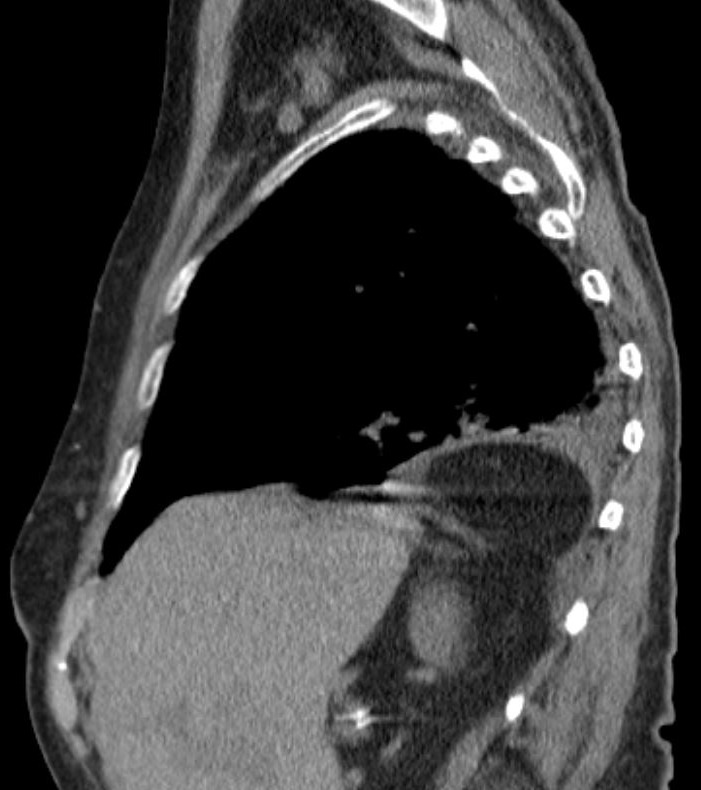Back


Poster Session D - Tuesday Morning
Category: Stomach
D0723 - Symptomatic Right-Sided Bochdalek Hernia in a 91-Year Old Female
Tuesday, October 25, 2022
10:00 AM – 12:00 PM ET
Location: Crown Ballroom

Has Audio

Abelardo Broceta, MD
Larkin Community Hospital
Miami, FL
Presenting Author(s)
Carlos M. Ramos Pachon, MD1, Abelardo Broceta, MD2, Andrew M. Dam, DO1, Luis Nasiff, MD, FACG1
1Larkin Community Hospital, Hialeah, FL; 2Larkin Community Hospital, South Miami, FL
Introduction: Bochdalek hernia (BH) is a type of congenital diaphragmatic hernia that occurs due to a defect in the posterior attachment of the diaphragm when there is a failure of pleuroperitoneal membrane closure in utero, associated with severe pulmonary complications during perinatal life. The prevalence of BH in adults is only 0.17%, of these, 20% are right-sided. We present a case of right sided BH in an adult .
Case Description/Methods: A 91-year old female with a past medical history of hypertension, coronary artery disease, ulcerative colitis, laparoscopic cholecystectomy, colostomy, and parastomal hernia with repair, presented to the emergency room with the chief complaint of intermittent epigastric abdominal pain that radiated to the back, nausea, and early satiety for a one week duration. A CT scan of the abdomen without contrast showed a non-complicated right-sided BH containing fat. As the patient was considered a poor candidate for surgery, the patient received conservative treatment.
Discussion: A Bochdalek hernia is a rare type of congenital diaphragmatic hernia that occurs due to failure of the pleuroperitoneal membrane closure in utero. There are fewer than 150 reported cases of adult BH. Nowadays, the term “congenital diaphragmatic hernia” is preferred for hernias presenting in the neonatal period, as a result of large central diaphragmatic defects, which allows the protrusion of abdominal viscera into the thoracic cavity. The term “Bochdalek hernia” is preferred for localized herniations through small diaphragmatic defects, occurring later in life without obvious symptoms.
Although the formation of BH occurs in-utero, it may only become evident once it causes clinical symptoms in adulthood and is often revealed after trauma or during laparoscopic surgery, which raises intraabdominal pressure. Our patient had a prior history of multiple abdominal surgeries, which may have aided in revealing an underlying BH defect.
Adult BH is reported with an incidence of 0.17% with only 58 cases of right sided Bochdalek hernias described. Most of these cases are asymptomatic but the most common symptoms are abdominal pain, dyspnea, postprandial fullness, nausea, or vomiting.
BH is a rare condition discovered incidentally therefore it is important for physicians to be aware of BH as a possible diagnosis in patients with symptoms of abdominal pain, postprandial fullness, nausea and vomiting associated with difficulty breathing, and history of multiple abdominal surgeries.

Disclosures:
Carlos M. Ramos Pachon, MD1, Abelardo Broceta, MD2, Andrew M. Dam, DO1, Luis Nasiff, MD, FACG1. D0723 - Symptomatic Right-Sided Bochdalek Hernia in a 91-Year Old Female, ACG 2022 Annual Scientific Meeting Abstracts. Charlotte, NC: American College of Gastroenterology.
1Larkin Community Hospital, Hialeah, FL; 2Larkin Community Hospital, South Miami, FL
Introduction: Bochdalek hernia (BH) is a type of congenital diaphragmatic hernia that occurs due to a defect in the posterior attachment of the diaphragm when there is a failure of pleuroperitoneal membrane closure in utero, associated with severe pulmonary complications during perinatal life. The prevalence of BH in adults is only 0.17%, of these, 20% are right-sided. We present a case of right sided BH in an adult .
Case Description/Methods: A 91-year old female with a past medical history of hypertension, coronary artery disease, ulcerative colitis, laparoscopic cholecystectomy, colostomy, and parastomal hernia with repair, presented to the emergency room with the chief complaint of intermittent epigastric abdominal pain that radiated to the back, nausea, and early satiety for a one week duration. A CT scan of the abdomen without contrast showed a non-complicated right-sided BH containing fat. As the patient was considered a poor candidate for surgery, the patient received conservative treatment.
Discussion: A Bochdalek hernia is a rare type of congenital diaphragmatic hernia that occurs due to failure of the pleuroperitoneal membrane closure in utero. There are fewer than 150 reported cases of adult BH. Nowadays, the term “congenital diaphragmatic hernia” is preferred for hernias presenting in the neonatal period, as a result of large central diaphragmatic defects, which allows the protrusion of abdominal viscera into the thoracic cavity. The term “Bochdalek hernia” is preferred for localized herniations through small diaphragmatic defects, occurring later in life without obvious symptoms.
Although the formation of BH occurs in-utero, it may only become evident once it causes clinical symptoms in adulthood and is often revealed after trauma or during laparoscopic surgery, which raises intraabdominal pressure. Our patient had a prior history of multiple abdominal surgeries, which may have aided in revealing an underlying BH defect.
Adult BH is reported with an incidence of 0.17% with only 58 cases of right sided Bochdalek hernias described. Most of these cases are asymptomatic but the most common symptoms are abdominal pain, dyspnea, postprandial fullness, nausea, or vomiting.
BH is a rare condition discovered incidentally therefore it is important for physicians to be aware of BH as a possible diagnosis in patients with symptoms of abdominal pain, postprandial fullness, nausea and vomiting associated with difficulty breathing, and history of multiple abdominal surgeries.

Figure: Figure 1: Lateral CT Chest with evidence of diaphragmatic hernia in the posterior 1/3.
Disclosures:
Carlos Ramos Pachon indicated no relevant financial relationships.
Abelardo Broceta indicated no relevant financial relationships.
Andrew Dam indicated no relevant financial relationships.
Luis Nasiff indicated no relevant financial relationships.
Carlos M. Ramos Pachon, MD1, Abelardo Broceta, MD2, Andrew M. Dam, DO1, Luis Nasiff, MD, FACG1. D0723 - Symptomatic Right-Sided Bochdalek Hernia in a 91-Year Old Female, ACG 2022 Annual Scientific Meeting Abstracts. Charlotte, NC: American College of Gastroenterology.
